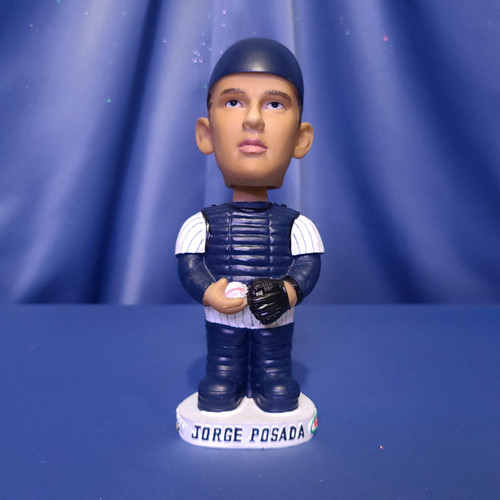Bobbleheads
A bobblehead, also known as a nodder, wobbler or bobble head, is a type of collectible toy. Its head is often oversized compared to its body. Instead of a solid connection, its head is connected to the body by a spring or hook in such a way that a light tap will cause the head to bobble, hence the name.
During the seventeenth-century, figurines of Buddha and other religious figures called "temple nodders" were produced in Asia. The earliest known Western reference to a bobblehead is thought to be in Nikolai Gogol's 1842 short story "The Overcoat", in which the main character's neck was described as "like the necks of plaster cats which wag their heads". During the nineteenth-century, bisque-based bobbleheads were being made in limited quantities for the US market. Many of the bobbleheads in the US were produced in Germany, with an uptick in imports during the 1920's and 30's. By the 1950's, bobbleheads had a substantial surge in popularity, with items made of either plastic or bisque.
By 1960, Major League Baseball had gotten in on the action and produced a series of Papier-mâché bobblehead dolls, one for each team, all with the same cherubic face, and a few select players over time. The World Series held that year brought the first player-specific baseball bobbleheads, for Roberto Clemente, Mickey Mantle, Roger Maris, and Willie Mays, still all with the same face. Over the next decade bobbleheads were also created with ceramics. Within a few years, they would be produced for other sports as well as cartoon characters. One of the most famous bobbleheads of all time also hails from this era: The Beatles bobblehead set, which is a valuable collectible today.
The next increase in popularity took place during the late 1990's. Although older bobbleheads like the baseball teams and The Beatles were sought after by collectors during this period, new bobblehead dolls were few and far between. What finally prompted their resurgence was cheaper manufacturing processes, and the main bobblehead material switched, this time from ceramic to plastic. It was now possible to make bobbleheads in the very limited numbers necessary for them to be viable collectibles. On Aug. 2, 1997, the minor league Birmingham Barons gave away Barons Bobblehead Doll bobbleheads at a game. The first major league baseball team to offer a bobblehead giveaway was the San Francisco Giants, which distributed 35,000 Willie Mays head nodders at their May 9, 1999 game.
The variety of bobbleheads has grown to include even relatively obscure popular culture figures and notable people. The new millennium would bring a new type of bobblehead toy, the mini-bobblehead, standing just two or three inches tall and used for cereal prizes and such. Post Cereals in particular packaged 22 million mini bobble heads of MLB players with its cereal before opening day in 2002.
On November 18, 2014, it was announced that the National Bobblehead Hall of Fame and Museum would open in 2016 in Milwaukee, Wisconsin. The National Bobblehead HOF and Museum held a preview exhibit at RedLine Milwaukee from January 7th, 2016 through April 30, 2016, which showcased the largest public display of bobbleheads in history. The 2000s also saw the rise of a competitive market for personalized, on-demand bobbleheads, typically 6–7 inches tall, from a number of on-line vendors. In 2015 the Pope Francis bobblehead became so popular that a nationwide shortage was reported.
January 7, 2015 marked the inaugural National Bobblehead Day. In 2016 the Guinness Book of World Records mark for world's largest bobblehead was set at 15 feet tall. Named "Goldie", it was the result of a collaboration between Dino Rentos and BobbleHeads.com.




















